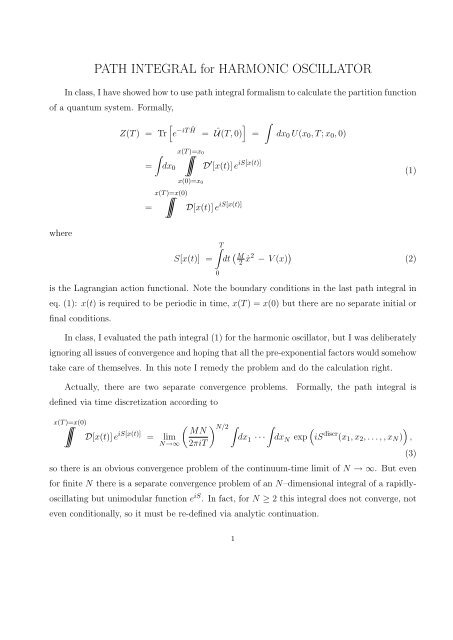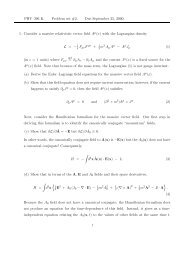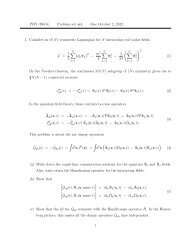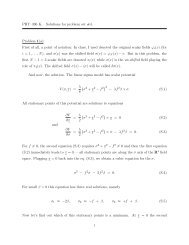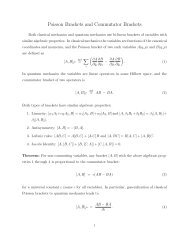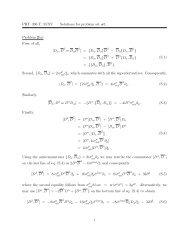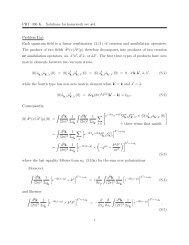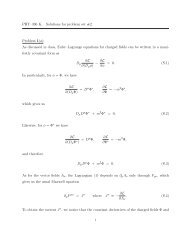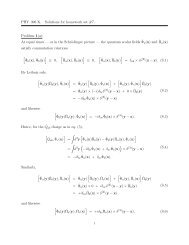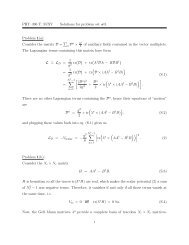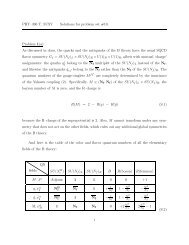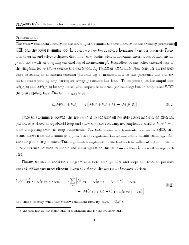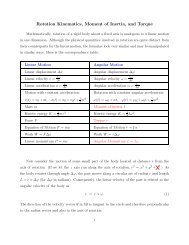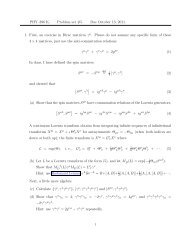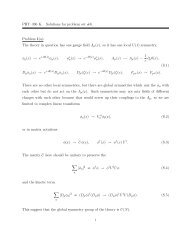PATH INTEGRAL for HARMONIC OSCILLATOR
PATH INTEGRAL for HARMONIC OSCILLATOR
PATH INTEGRAL for HARMONIC OSCILLATOR
Create successful ePaper yourself
Turn your PDF publications into a flip-book with our unique Google optimized e-Paper software.
<strong>PATH</strong> <strong>INTEGRAL</strong> <strong>for</strong> <strong>HARMONIC</strong> <strong>OSCILLATOR</strong>In class, I have showed how to use path integral <strong>for</strong>malism to calculate the partition functionof a quantum system. Formally,]Z(T ) = Tr[e −iT Ĥ = Û(T, 0)∫=x(T ∫)=x 0dx 0=∫dx 0 U(x 0 , T ; x 0 , 0)D ′ [x(t)] e iS[x(t)]x(0)=x 0(1)= D[x(t)] e iS[x(t)]x(T )=x(0) ∫whereS[x(t)] =∫ T0dt ( M2 ẋ 2 − V (x) ) (2)is the Lagrangian action functional. Note the boundary conditions in the last path integral ineq. (1): x(t) is required to be periodic in time, x(T ) = x(0) but there are no separate initial orfinal conditions.In class, I evaluated the path integral (1) <strong>for</strong> the harmonic oscillator, but I was deliberatelyignoring all issues of convergence and hoping that all the pre-exponential factors would somehowtake care of themselves. In this note I remedy the problem and do the calculation right.Actually, there are two separate convergence problems.defined via time discretization according toFormally, the path integral isx(T )=x(0) ∫( ) N/2 ∫ ∫MN()D[x(t)] e iS[x(t)] = limdxN→∞ 2πiT1 · · · dx N exp iS discr (x 1 , x 2 , . . . , , x N ) ,(3)so there is an obvious convergence problem of the continuum-time limit of N → ∞. But even<strong>for</strong> finite N there is a separate convergence problem of an N–dimensional integral of a rapidlyoscillatingbut unimodular function e iS . In fact, <strong>for</strong> N ≥ 2 this integral does not converge, noteven conditionally, so it must be re-defined via analytic continuation.1
The usual analytic continuation keeps the x n = x(t n ) real but makes the time itself imaginary,t = −it E which runs from 0 to T = −iβ. In field theory, t E is called the Euclidean timebecause the 4D spacetime spanned by (x 1 , x 2 , x 3 , x 4 = t E ) is Euclidean rather tan Minkowski.Going from the real Minkowski time t to the real Euclidean time t E = it turns the oscillatingphase functione iSdiscr= exp[iTNN∑n=1(M2( ) 2 xn − x n−1− V (x n ))](T/N)of the (discretized) path integral into a real narrowly peaked function exp(−S discr ) where thediscretized Euclidean actionS discrE = β NN∑n=1(M2( ) 2 xn − x n−1+ V (x n ))(β/N)E(4)receives positive contribution from both the Kinetic and the potential energy terms. In thecontinuous Euclidean time limitS E [x(t E )] =∫ βand the Euclidean path integral becomes0dt E[M2( dxdt E) 2+ V (x)x(β)=x(0)[Z E (β) = Tr e −βĤ] ∫= D[x(t E )] e −SE[x(tE)] . (7)Note that this Euclidean partition function is precisely the partition function of StatisticalMechanics, so it is well worth calculating in its own right.Unlike the Minkowski-time path Integral, the Euclidean path integral is well defined because<strong>for</strong> each finite N we have an absolutely convergent integral( ) N/2 ∫ ∫MN()dx2πβ1 · · · dx N exp −SE discr (x 1, x 2 , . . . , , x N ) , (8)and the continuous-Euclidean-time limit N → ∞ usually behaves well.](5)(6)Consequently, thetechnical definition of the Minkowski-time path integral is nothing but the analytic continuationof the Euclidean-time PI back to Minkowski time t = it E .2
as yk ∗ = y −k. The key <strong>for</strong>mula of the discrete Fourier trans<strong>for</strong>m isConsequently,∑e −2πi(k−l)n/N = Nδ mod N (k − l). (14)nmod∑Nnx 2 n =mod∑Nnx ∗ nx n =mod∑Nky ∗ k y k (15)and likewisemod ∑Nn(x n − x n−1 ) 2 =mod ∑Nk∣∣1 − e 2πik/N∣ ∣ ∣2y∗k y k (16)where the latter follows fromx n − x n−1 =mod∑NkN −1/2 e −2πikn/N ( 1 − e 2πik/N) y k .Thusand there<strong>for</strong>eSEdiscr [y k] = MN mod ∑N(4 sin 2 πk2βN + ω2 β 2 )N 2 |y k | 2 , (17)kZ(beta, ω, N) =( ) N/2 ∫MN× J(N) ×2πβ= J(N) ×mod∏Nkd N y e −Sdiscr E (y)(4 sin 2 πkN + ω2 β 2N 2 ) −1/2 (18)where J(N) is the Jacobian of the discrete Fourier trans<strong>for</strong>m (13). To evaluate this Jacobian,we per<strong>for</strong>m the Fourier trans<strong>for</strong>m twice:y k =mod ∑NmN −1/2 e −2πimk/N z m , x n =mod ∑NkN −1/2 e −2πikn/N y k = (−1) n z n , (19)4
which immediately tells us that[det ∂x ] 2n∂y k= det ∂x n∂z m= ±1and hence J = | det(∂x n /∂y k )| = 1 and there<strong>for</strong>eZ(β, ω, N) =mod∏Nk(4 sin 2 πkN + ω2 β 2N 2 ) −1/2. (20)At this point, let me use without proof a somewhat obscure mathematical <strong>for</strong>mulaN−1∏k=1(2 sin πk )Nwhich allows me to re-write the discretized partition function asZ(β, ω, N) =N N−1ωβ × ∏k=1(4 sin 2 πk(= 1 N−1ωβ × ∏1 +k=1= N, (21)N + ω2 β 2 ) −1/2N 2ω 2 β 24N 2 sin 2 πkN) −1/2(22)To evaluate the large N limit of this partition function (physically, the continuous timelimit), we approximate 4N 2 sin 2 (πk/N) ≈ (2πk) 2 <strong>for</strong> k ≪ N, and likewise 4N 2 sin 2 (πk/N) ≈(2π(N − k)) 2 <strong>for</strong> (N − k) ≪ N, while <strong>for</strong> the remaining modes sin 2 (πk/N) = O(1) and henceConsequently,1Z(β, ω, N) −−→N≫1 ωβ ×−−−→N→∞∏1≤k≪N1∞ωβ × ∏k=11 +(1 + ω2 β 2ω 2 β 24N 2 sin 2 πkN(2πk) 2 ) −1/2×(1 + ω2 β 2 ) −1(2πk) 2 .≈ 1.∏1≤(N−k)≪NIt remains to evaluate the infinite product in the last <strong>for</strong>mula.(1 +ω 2 β 2 ) −1/2(2π(N − k)) 2(23)Consider Z(ωβ) as ananalytic function of a complex argument. Whenever any factor of on the right hand side has5
a zero in the complex (ωβ) plane, Z(ωβ) has a zero and ditto <strong>for</strong> the poles. Also, the productconverges, so these are the only poles and zeroes of the Z(ωβ) The individual factors at handare 1/(ωβ) and1=1 + ω2 β 2(2πk) 2(2πk) 2(ωβ + 2πki) × (ωβ − 2πki)<strong>for</strong> k = 1, 2, 3, . . .. Thus, the Z(ωβ) function has no zeroes and it has poles at ωβ = 2πki <strong>for</strong>all integers k (positive, negative and zero). In other words, it has the same poles and zeroes asthe 1/ sinh(ωβ/2) function and indeed, there is a well known <strong>for</strong>mulasinh(z) = z+∞ ∏k=1(1 + z2(πk) 2 ).Thus, at the end of the long path-integral calculation, we arrive at a rather simple <strong>for</strong>mulaZ E (β) =12 sinh(ωβ/2)(24)in Euclidean time, and by analytic continuation to Minkowski timeZ M (T ) =12i sin(ωT/2) . (25)Expanding the latter partition function into a sum of e −iET phases, we have12i sin(ωT/2) =e−iωT/2 ∞ 1 − e −iωT = ∑n=01 × exp ( −iT × (n + 1 2 )ω) , (26)Spectrumwhich immediately tells us that the harmonic oscillator has non-degenerate energy spectrumwith eigenvalues E n = (n +2 1 )ω. Of course, we new that long be<strong>for</strong>e this calculation, but itconfirms that (properly applied) path-integral <strong>for</strong>malism does yield the correct spectrum.6


